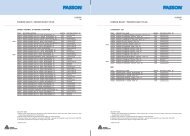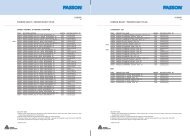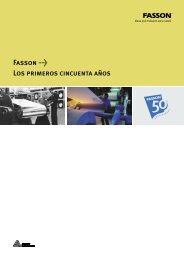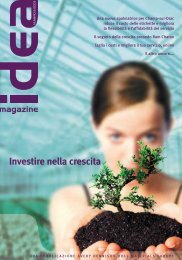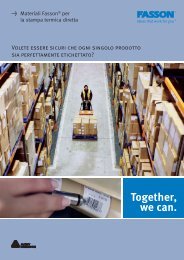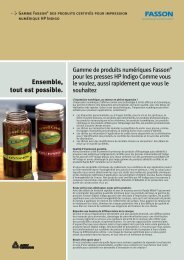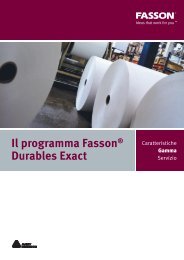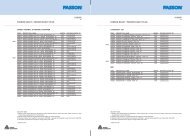open your EYES to MORE labelling SOLUTIONS - Avery Dennison ...
open your EYES to MORE labelling SOLUTIONS - Avery Dennison ...
open your EYES to MORE labelling SOLUTIONS - Avery Dennison ...
You also want an ePaper? Increase the reach of your titles
YUMPU automatically turns print PDFs into web optimized ePapers that Google loves.
Number of printers in Millions<br />
2. The printing processes<br />
Inkjet printing with Fasson<br />
self-adhesive roll labels<strong>to</strong>ck.<br />
Self-adhesive materials for inkjet<br />
printing are increasing in demand,<br />
and are currently exhibiting a doubledigit<br />
growth rate – a direct result of<br />
the success of the A4 ‘desk<strong>to</strong>p’ inkjet<br />
printers. These printers dominate<br />
the small offi ce market due <strong>to</strong> the<br />
simplicity of operation and the<br />
relatively low printer costs.<br />
The inkjet printing process.<br />
Inkjet printing delivers droplets of ink<br />
from a nozzle directly on<strong>to</strong> a receiver.<br />
Two types are available: continuous<br />
inkjet (mainly used for direct<br />
marketing) and drop-on-demand<br />
(where a label is generally required).<br />
Drop-on-demand printing can be<br />
achieved by two different processes<br />
- thermal inkjet and piezo inkjet.<br />
Thermal inkjet is <strong>to</strong>day’s most<br />
common technology, used in 90% of<br />
Printers installed in Western Europe<br />
Monochrome Laser<br />
Colour Inkjet<br />
Monochrome Inkjet<br />
Desk<strong>to</strong>p Colour Laser<br />
Colour Laser Copier/Printer<br />
desk<strong>to</strong>p inkjet printers because of<br />
the relatively low printhead cost. This<br />
process forms a bubble of ink, heated<br />
through electrical pulses.<br />
Piezo inkjet is challenging this<br />
technology with the advantage of<br />
greater dot control in terms of both<br />
sizes and speed due <strong>to</strong> the technique<br />
of dot formation.<br />
The printhead is fi tted with a piezo<br />
crystal, which deforms with electrical<br />
impulse and creates and displaces<br />
the bubble of ink. Due <strong>to</strong> the accuracy<br />
of dot formation with this process, it<br />
is possible <strong>to</strong> create pho<strong>to</strong> images of<br />
1200x1200 DPI - though printhead<br />
costs are higher. Both processes<br />
require a specially formulated <strong>to</strong>p<br />
coating <strong>to</strong> optimise colour print<br />
receptivity, and for bar code printing.<br />
Laser and copier printing<br />
with Fasson self-adhesive roll<br />
labels<strong>to</strong>ck. Driven by the increased<br />
sales of desk<strong>to</strong>p printers for both the<br />
home and the offi ce environments,<br />
the laser copier market is one of<br />
the fastest-growing segment in the<br />
variable information printing market.<br />
The technology’s ability <strong>to</strong> produce<br />
high resolution and durable images<br />
at high print speeds has also created<br />
growth in industrial markets.<br />
Typical applications include address<br />
labels, pallet labels, pharmaceutical<br />
labels and component labels in the<br />
electrical and au<strong>to</strong>motive industries.<br />
The laser and copier printing<br />
process. The electropho<strong>to</strong>graphic<br />
(<strong>to</strong>ner transfer) processes include<br />
laser copiers and pho<strong>to</strong> copiers (LED),<br />
which operate by similar principles: an<br />
image is scanned by a light beam or<br />
high-speed fl ash and refl ected on<strong>to</strong> a<br />
pho<strong>to</strong>conduc<strong>to</strong>r drum, which creates<br />
a charge.<br />
Laser printers differ from pho<strong>to</strong>copiers<br />
in that the image is sent digitally <strong>to</strong><br />
the pho<strong>to</strong>conduc<strong>to</strong>r drum. In both,<br />
however, <strong>to</strong>ner particles are attracted<br />
<strong>to</strong> the drum and then transferred and<br />
fi xed on<strong>to</strong> the paper or fi lm receiver<br />
using heat and pressure.<br />
These are generally sheet-fed<br />
printing processes, which are very<br />
easy <strong>to</strong> use, but place high demands<br />
on the labels<strong>to</strong>ck <strong>to</strong> ensure clean<br />
and effi cient feed through the<br />
printers, which can have winding<br />
transportation paths.



